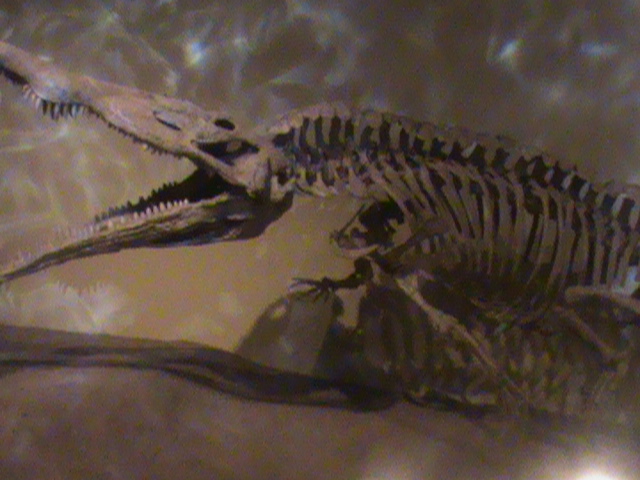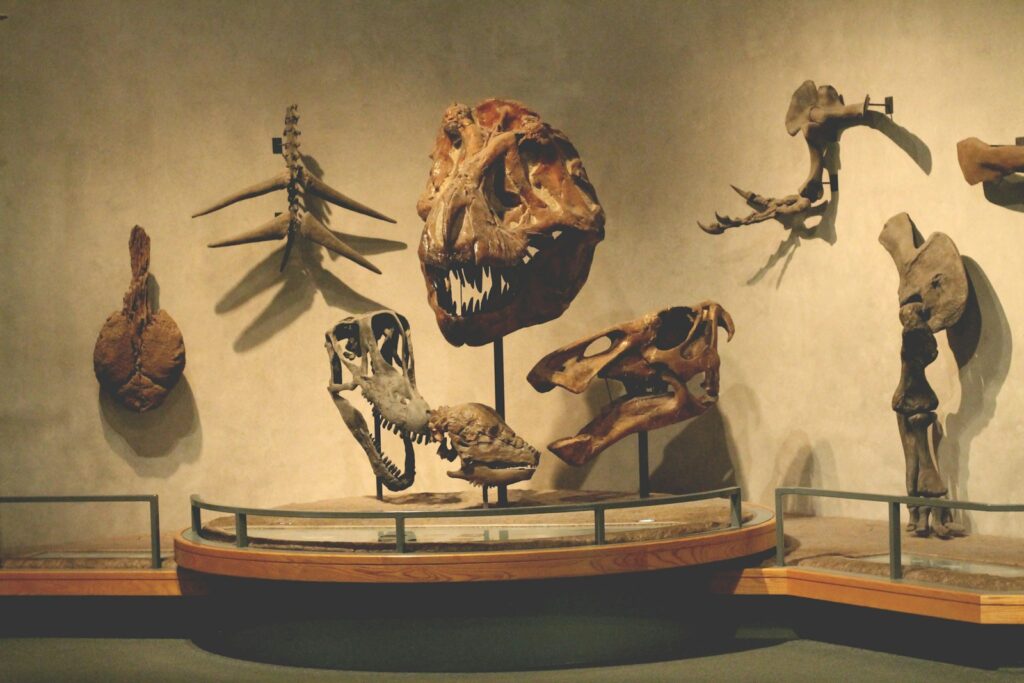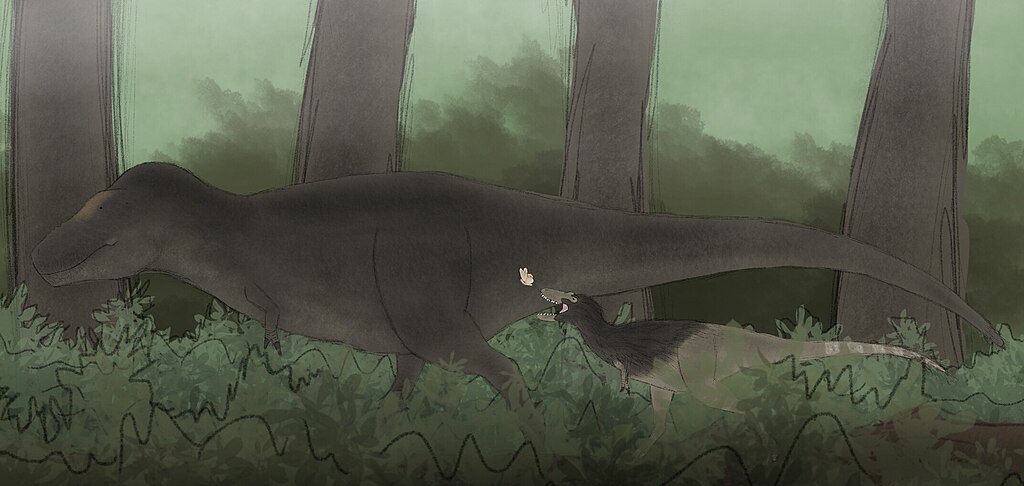The prehistoric world was a battleground where death lurked behind every fern and terror stalked through ancient forests. For over 180 million years, Earth’s landscapes trembled under the footsteps of apex predators that would make today’s most fearsome hunters look like house pets. From the dawn of the dinosaur age to its catastrophic end, these magnificent beasts engaged in life-or-death struggles that shaped the very course of evolution itself.
The Dawn of Terror: Coelophysis vs. Desmatosuchus

Picture the late Triassic period, around 220 million years ago, when the first dinosaurs were just finding their footing in a world still dominated by archosaurs. The slender, pack-hunting Coelophysis represented the future of predation, while the heavily armored Desmatosuchus embodied the old guard’s defensive strategies.
Coelophysis, measuring about 10 feet long, possessed razor-sharp teeth and incredible speed that allowed it to dart between the legs of larger prey. These early dinosaurs hunted in coordinated groups, using their intelligence and agility to overwhelm opponents. When confronted with a 16-foot Desmatosuchus, covered in bony armor plates and wielding a powerful tail club, the outcome wasn’t always certain.
The encounters between these ancient adversaries were brutal chess matches of endurance versus agility. Desmatosuchus could withstand multiple attacks thanks to its natural armor, but Coelophysis packs would relentlessly probe for weak spots, particularly targeting the softer underbelly and joints between armor plates.
Jurassic Juggernauts: Allosaurus vs. Stegosaurus

The Jurassic period brought us one of prehistory’s most iconic confrontations, immortalized in countless documentaries and museum displays. Allosaurus, the lion of its time, faced off against the walking fortress known as Stegosaurus in battles that defined an entire era.
Standing 12 feet tall and stretching 28 feet long, Allosaurus possessed massive claws and serrated teeth designed for slicing through flesh and bone. Its powerful legs could propel it at speeds of up to 25 mph, making it a formidable pursuit predator. The creature’s most distinctive feature was its pronounced skull ridges, which may have been used for display or protection during combat.
Stegosaurus, however, was no easy target despite its plant-eating diet. Armed with four massive spikes on its tail – paleontologists call this weapon the “thagomizer” – this 30-foot herbivore could deliver devastating blows capable of puncturing even Allosaurus’s thick hide. The double row of plates along its back wasn’t just for show; they likely helped regulate body temperature and made the animal appear larger and more intimidating to potential predators.
Pack Hunters vs. Armored Titans: Utahraptor vs. Iguanodon
The early Cretaceous period witnessed perhaps the most terrifying predator-prey dynamic in Earth’s history. Utahraptor, a massive dromaeosaurid standing 7 feet tall and weighing over 1,500 pounds, possessed sickle-shaped claws that could grow up to 24 inches long – longer than a baseball bat.
These feathered nightmares hunted in coordinated packs, using their intelligence and devastating weapons to bring down prey many times their size. Their primary target was often Iguanodon, a 30-foot herbivore with thumb spikes that could serve as formidable defensive weapons. The discovery of a fossilized Utahraptor actually embedded in an Iguanodon’s ribs tells us these encounters were far from one-sided affairs.
When a pack of Utahraptor attacked, they would leap onto their prey’s back and flanks, using their massive claws to anchor themselves while delivering fatal wounds. Iguanodon’s best defense was its powerful legs and sharp thumb spikes, which could impale an attacking predator if positioned correctly. These battles were fast, brutal, and often ended with casualties on both sides.
Aquatic Apocalypse: Kronosaurus vs. Elasmosaurus

While land-based predators dominated the headlines, the oceans hosted their own epic confrontations. Kronosaurus, a short-necked plesiosaur with a skull over 9 feet long, ruled the Cretaceous seas like a living submarine armed with teeth the size of bananas.
This 36-foot marine reptile possessed jaw muscles so powerful they could crush a small car. Its streamlined body and powerful flippers made it an efficient swimmer capable of surprising even the most alert prey. When Kronosaurus set its sights on the elegant Elasmosaurus, with its impossibly long neck and small head, the encounter resembled a clash between a submarine and a sea serpent.
Elasmosaurus, stretching up to 46 feet in length, used its 23-foot neck like a fishing rod, plucking small fish and squid from the water column. But when threatened by Kronosaurus, this gentle giant could whip its massive body around with surprising speed, potentially delivering crushing blows with its powerful tail. The key to survival lay in detecting the approach of death before it was too late.
Aerial Assault: Quetzalcoatlus vs. Parasaurolophus
The skies of the late Cretaceous belonged to giants that dwarfed modern birds. Quetzalcoatlus, with a wingspan reaching 36 feet, was essentially a flying giraffe – a creature so large it defied imagination. These pterosaurs didn’t just scavenge; they were active predators capable of taking down sizeable prey.
Standing 16 feet tall when grounded, Quetzalcoatlus possessed a beak longer than a human body and neck muscles powerful enough to spear large dinosaurs. Its hunting strategy involved soaring high above the landscape, using its incredible eyesight to spot potential victims below. When it identified a target like a young Parasaurolophus, the attack was swift and deadly.
Parasaurolophus, despite being herbivorous, was no pushover. These duck-billed dinosaurs could reach speeds of 25 mph and possessed powerful legs capable of delivering bone-crushing kicks. Their sophisticated vocal communication system allowed herds to coordinate responses to aerial threats, creating a network of early warning systems that often meant the difference between life and death.
Forest Phantoms: Carnotaurus vs. Amargasaurus
South America during the Cretaceous period was home to some of the most unusual predator-prey relationships in Earth’s history. Carnotaurus, the “meat-eating bull,” was a bizarre theropod with forward-facing horns and tiny, almost useless arms that made T. rex look well-equipped by comparison.
This 26-foot predator was built for speed, with long, powerful legs that could propel it at speeds exceeding 35 mph – faster than any large predator alive today. Its hunting strategy relied on pursuit and ramming attacks, using its horned skull like a battering ram. When faced with Amargasaurus, a 30-foot sauropod with distinctive parallel spines along its neck, these encounters became tests of speed versus defensive architecture.
Amargasaurus couldn’t match Carnotaurus for speed, but its spiny defenses and powerful tail made it a dangerous opponent. The sauropod’s strategy involved backing against trees or rock formations to limit the predator’s approach angles while using its whip-like tail to deliver stunning blows. These forest battles were often prolonged affairs where stamina proved as important as strength.
Island Warfare: Majungasaurus vs. Rapetosaurus

Madagascar during the late Cretaceous was an island laboratory where evolution took unexpected turns. Majungasaurus, a 23-foot predator with a distinctive horn on its forehead, ruled this isolated ecosystem with an iron fist. What made this theropod particularly terrifying was its documented cannibalistic behavior – it regularly ate members of its own species.
The island’s primary large herbivore, Rapetosaurus, was a 49-foot sauropod that had adapted to Madagascar’s unique environment. Unlike its mainland relatives, this titanosaur was relatively small and agile, traits that helped it survive in an ecosystem with limited resources and a particularly aggressive apex predator.
The confined nature of island life meant these two species encountered each other regularly, leading to an evolutionary arms race. Majungasaurus developed powerful crushing jaws capable of processing bone, while Rapetosaurus evolved enhanced herd behaviors and defensive strategies. The fossil evidence suggests these encounters were frequent and brutal, with both species bearing scars from their ongoing conflict.
River Valley Rampage: Spinosaurus vs. Sarcosuchus
The river systems of Cretaceous Africa hosted one of prehistory’s most spectacular apex predator confrontations. Spinosaurus, at 50 feet long and sporting a massive sail on its back, was perfectly adapted for a semi-aquatic lifestyle, while Sarcosuchus, a 40-foot crocodilian nicknamed “SuperCroc,” represented the ultimate ambush predator.
When these two titans met in the murky waters of ancient rivers, the encounters were explosive. Spinosaurus possessed powerful claws designed for catching fish, but they were equally effective weapons against other predators. Its elongated snout and conical teeth were perfectly suited for aquatic hunting, while its powerful legs allowed it to wade through water with surprising speed.
Sarcosuchus, with its massive 6-foot skull and bite force exceeding that of T. rex, was essentially a living bear trap. This ancient crocodilian could remain motionless for hours, waiting for the perfect moment to strike. When Spinosaurus ventured too close, the resulting battle was a clash between active hunting and patient ambush tactics – a confrontation that could go either way depending on who struck first.
The Ultimate Showdown: Tyrannosaurus Rex vs. Triceratops

No discussion of prehistoric predator confrontations would be complete without the most famous matchup in paleontological history. T. rex, the undisputed king of the dinosaurs, regularly faced off against Triceratops, a three-horned herbivore built like a living tank.
Standing 13 feet tall and measuring 40 feet long, T. rex possessed the most powerful bite force of any land animal in Earth’s history – capable of crushing a car with its jaws. Its 60 teeth, some as long as railroad spikes, were continuously replaced throughout its lifetime. When this apex predator set its sights on a 26-foot Triceratops, the resulting battle was prehistoric warfare at its finest.
Triceratops wasn’t just a passive victim; it was a 12-ton bulldozer armed with three massive horns and a bone frill that could deflect even T. rex’s devastating bite. Fossil evidence shows these encounters were common, with many T. rex teeth found embedded in Triceratops bones and vice versa. The key to victory often lay in positioning – T. rex needed to attack from the side or rear to avoid those deadly horns, while Triceratops had to keep its armored head pointed toward the threat.
Aftermath and Legacy
These epic confrontations shaped the course of evolution for millions of years, driving the development of increasingly sophisticated hunting strategies and defensive mechanisms. Each predator-prey relationship created an evolutionary arms race that pushed both species to their biological limits.
The fossil record preserves these ancient battles in stunning detail, from bite marks on bones to complete skeletons locked in eternal combat. These discoveries help us understand that prehistoric life was far more dynamic and violent than early paleontologists imagined. The strategies developed by these ancient predators continue to influence modern ecosystems, with many hunting behaviors traceable back to these Mesozoic origins.
The sudden extinction of these magnificent creatures 66 million years ago marked the end of an era, but their legacy lives on in the birds that soar overhead and the crocodiles that still patrol our waterways. What other secrets might these ancient battlefields reveal as we continue to uncover their fossilized remains?



